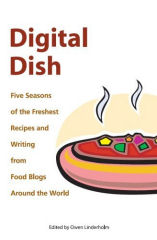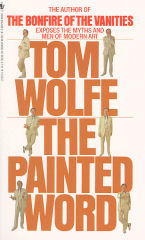Buenos Aires – You’d think with all the time I spend exploring and writing I wouldn’t have time to read anything, but it just ain’t so. A lot of my reading gets done while sitting on colectivos rocketing around the city, much of it while having coffee or over lunch (only, of course, when I’m “dining” by myself), and some while waiting in any one of the seemingly endless lines here. Yesterday I managed to read an entire book while waiting at the Ministry of Justice to have my fingerprints taken for my residency visa (they scan your fingerprints with a laser directly onto the computer – no messy ink and cards – quite cool).
 It’s sometimes hard to remember how quickly technology and the daily use of it has expanded over a very short time. When I stop to think about it, I grew up without things like an answering machine, computer, or cellphone. We had a black and white television set until I was just about into the double digits of age (in fact, I took that very b&w tv with me when I went off to college). I used, believe it or not, a slide rule (which I still have, and know how to use), until I was a junior in high school; come to think of it, I still have the calculator I got as a birthday gift that year. My first computer was something called an ELF, not counting the little 8-bit switches and LEDs thing that my friend Stan and I put together in his basement. The internet did not exist until I was 11 years old (1969), and then only as an experiment called ARPAnet, which was a network designed to connect university laboratories that were working on military contracts together. In 1981, fewer than 300 computers were linked to the Internet, and by 1989, the number stood at fewer than 90,000 computers. By 1993, over 1,000,000 computers were linked. Today, more than 10 million host computers worldwide are linked to the Internet, with well over 200 million Internet users taking advantage of those connections. The term “weblog” was coined by Jorn Barger on 17 December 1997. The short form, “blog,” was coined by Peter Merholz. He broke the word weblog into the phrase “we blog” in the sidebar of his weblog in April of 1999.
It’s sometimes hard to remember how quickly technology and the daily use of it has expanded over a very short time. When I stop to think about it, I grew up without things like an answering machine, computer, or cellphone. We had a black and white television set until I was just about into the double digits of age (in fact, I took that very b&w tv with me when I went off to college). I used, believe it or not, a slide rule (which I still have, and know how to use), until I was a junior in high school; come to think of it, I still have the calculator I got as a birthday gift that year. My first computer was something called an ELF, not counting the little 8-bit switches and LEDs thing that my friend Stan and I put together in his basement. The internet did not exist until I was 11 years old (1969), and then only as an experiment called ARPAnet, which was a network designed to connect university laboratories that were working on military contracts together. In 1981, fewer than 300 computers were linked to the Internet, and by 1989, the number stood at fewer than 90,000 computers. By 1993, over 1,000,000 computers were linked. Today, more than 10 million host computers worldwide are linked to the Internet, with well over 200 million Internet users taking advantage of those connections. The term “weblog” was coined by Jorn Barger on 17 December 1997. The short form, “blog,” was coined by Peter Merholz. He broke the word weblog into the phrase “we blog” in the sidebar of his weblog in April of 1999.
The first food blogs began appearing, really, only a few years ago, roughly in 2000. Owen Linderholm, the editor of this book, discovered food blogging around then, and points out that as of the summer of 2003, the opening of the book, there were fewer than 50 food blogs out there that he was able to track down. Today, there are literally thousands. Digital Dish presents selected postings from two dozen food blogs over the span of “five seasons,” from the summer of 2003 through the summer of 2004. It’s an interesting compendium of very different styles of writing and presentation, left more or less intact as they were first posted (sans, for the most part, photos), mistakes and all, with minimal commentary by Owen introducing each post. For me, the most fascinating part is seeing the development of the authors’ voices, from timid sort of “gee here’s a recipe I hope you’ll like if anyone’s really reading this I want to hear what you think but please don’t be mean to me” to confident discourses on a variety of food topics and their own kitchen adventures. Most, if not all of the blogs included are still actively going (and still steadily getting better), including Owen’s own Tomatilla. If food blogging is a subject that interests you more than just casually reading my musings, the book is a worthwhile glimpse into its “history”.
 I have commented more than once on my complete lack of ability to appreciate Modern Art. After our visit to the Museum of Modern Art in New York, my friend Frank gave me a copy of Tom Wolfe’s The Painted Word. I stuck it on my reading pile and only grabbed it yesterday when I knew I needed something to read while standing in line for my aforementioned fingerprints. In the after-moments of reading the book, all I could think of was, if I could write like Tom Wolfe, I could have written this book. Of course, I’d have to have put in the time he did reading commentary on art, something I just don’t think I could bring myself to do. The important point, however, is that, like his epiphany at the beginning of the book, I “discovered” that Modern Art exists and is appreciated only by those who have the code, who know the theory, who understand the text behind the art. Without that knowledge, looking at Modern Art is simply an exercise in futility – one such as myself really is only capable of seeing squiggles, lines, and paint drips. If, however, you know the theory – if you know why the artist painted what he or she painted – it all becomes clear, and suddenly you can see the greatness in the work. Modern Art is the illustration of its own theories. Modern Art is not something to be appreciated for itself, nor how well it goes with the sofa in the corner. I feel so much better about myself now. Given my lack of commitment to understand those theories I shall probably never appreciate Modern Art, but I can go blithely forward knowing that it is by choice as opposed to lack of perceptual ability.
I have commented more than once on my complete lack of ability to appreciate Modern Art. After our visit to the Museum of Modern Art in New York, my friend Frank gave me a copy of Tom Wolfe’s The Painted Word. I stuck it on my reading pile and only grabbed it yesterday when I knew I needed something to read while standing in line for my aforementioned fingerprints. In the after-moments of reading the book, all I could think of was, if I could write like Tom Wolfe, I could have written this book. Of course, I’d have to have put in the time he did reading commentary on art, something I just don’t think I could bring myself to do. The important point, however, is that, like his epiphany at the beginning of the book, I “discovered” that Modern Art exists and is appreciated only by those who have the code, who know the theory, who understand the text behind the art. Without that knowledge, looking at Modern Art is simply an exercise in futility – one such as myself really is only capable of seeing squiggles, lines, and paint drips. If, however, you know the theory – if you know why the artist painted what he or she painted – it all becomes clear, and suddenly you can see the greatness in the work. Modern Art is the illustration of its own theories. Modern Art is not something to be appreciated for itself, nor how well it goes with the sofa in the corner. I feel so much better about myself now. Given my lack of commitment to understand those theories I shall probably never appreciate Modern Art, but I can go blithely forward knowing that it is by choice as opposed to lack of perceptual ability.
Actually, I enjoyed the book a great deal. It really is a rather clear, and quite humorous, look at the development of the world of Modern Art, its roots, its theories, and its critics. I have no doubt that amongst the cognoscenti it is one of those sorts of books that either completely offends “how dare you suggest that Modern Art is not really art” or is embraced “see, now you truly understand”. The book was written in 1975, and based on a quick Amazon search appears to be out of print but readily available. I recommend it as an enjoyable read for anyone who is as mystified by the oddity of Modern Art as I am, errr, was. It’s especially good when standing in line for several hours somewhere waiting for the red tape to clear.